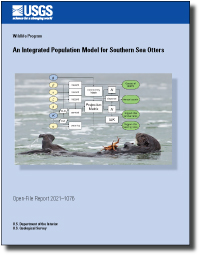An Integrated Population Model for Southern Sea Otters
Links
- Document: Report (6.5 MB pdf) , XML
- Download citation as: RIS | Dublin Core
Abstract
Southern sea otters (Enhydra lutris nereis) have recovered slowly from their near extinction a century ago, and their continued recovery has been challenged by multiple natural and anthropogenic factors. Development of an integrated population model (IPM) for southern sea otters has been identified as a management priority, to help in evaluating the relative impacts of known threats and guide best management options for species recovery. An IPM represents an analytical modeling framework where various types of data relevant to animal health, population trends, and survival can be evaluated collectively to project future population dynamics under different resource management scenarios. Here, we describe the development of a spatially explicit IPM for southern sea otters that is fit by using Bayesian methods to multiple datasets including a time series of range-wide survey counts, estimated survival rates of tagged animals from telemetry-based population studies, and cause-of-death data from comprehensive necropsies of beach-cast carcasses. The core of the model is a stage-structured matrix, in which survival rates for a given life history stage, year, and location are computed as the outcome of multiple ‘competing risks,’ or hazards, allowing for spatiotemporal variation in each hazard, density-dependence, and stochasticity. The parameterized IPM was used to (1) examine how age and sex-specific hazards vary over space and time, (2) gain insights into density-dependent variation in specific hazards, (3) assess population-level effects of known mortality hazards in the past and in future projections, and (4) evaluate the relative benefits of various potential management actions to address these hazards.
Our results indicated that different types of hazards have variable impacts at different life history stages of sea otters; for example, shark-bite mortality had a strong impact on mortality of subadult females but relatively low impacts on aged adult female survival, whereas End Lactation Syndrome showed just the opposite age-based pattern. There also was spatial and temporal variation in exposure to different hazards; for example, shark-bite mortality generally was highest at the north and south ends of the sea otter range, End Lactation Syndrome and cardiac disease were highest in the center part of the range, and harmful algal bloom intoxication and protozoal infection mortalities were highest around Morro Bay. The relative impacts of hazards depended on population density; for example, shark-bite mortality had the greatest effect on male survival when population abundance was low, but as densities increased the impacts of cardiac disease (for aged adults) and acanthocephalan peritonitis (for subadults) exceeded the effects of shark-bite mortality. Sensitivity analyses showed that modifying certain hazard rates can have substantial impacts on future population growth; for example, if the shark-bite hazard rate were to decrease by 20 percent, projected abundance after 50 years is predicted to be 18-percent higher, on average, than under baseline conditions. We used the IPM to evaluate the possible impacts of a potential management action: the reintroduction of sea otters to currently unoccupied parts of their historical range. We found that there were large increases in expected growth potential associated with reintroduction programs to various locations to the north and south of the currently occupied range, although a reintroduction to San Francisco Bay was projected to have the greatest potential impacts on future population growth.
The IPM for southern sea otters presented here provides resource managers with a useful tool for evaluating the impacts of specific hazards, forecasting future population dynamics and range expansion, and evaluating alternative management scenarios.
Suggested Citation
Tinker, M.T., Carswell, L.P., Tomoleoni, J.A., Hatfield, B.B., Harris, M.D., Miller, M.A., Moriarty, M.E., Johnson, C.K., Young, C., Henkel, L.A., Staedler, M.M., Miles, A.K., and Yee, J.L., 2021, An integrated population model for southern sea otters: U.S. Geological Survey Open-File Report 2021–1076, 50 p., https://doi.org/10.3133/ofr20211076.
ISSN: 2331-1258 (online)
Study Area
Table of Contents
- Acknowledgments
- Abstract
- Introduction
- Methods
- Results
- Discussion
- References Cited
- Appendix 1. Supplementary Tables and Figures
| Publication type | Report |
|---|---|
| Publication Subtype | USGS Numbered Series |
| Title | An integrated population model for southern sea otters |
| Series title | Open-File Report |
| Series number | 2021-1076 |
| DOI | 10.3133/ofr20211076 |
| Publication Date | August 16, 2021 |
| Year Published | 2021 |
| Language | English |
| Publisher | U.S. Geological Survey |
| Publisher location | Reston, VA |
| Contributing office(s) | Western Ecological Research Center |
| Description | vii, 50 p. |
| Country | United States |
| State | California |
| Online Only (Y/N) | Y |


